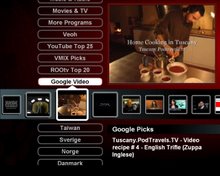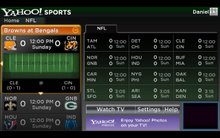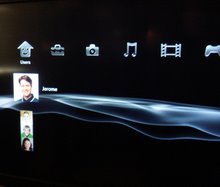The Issue: Widget use on the TV has become an increasingly popular topic. Constructing mini-programs in the form of “widget” chunks allows a user to select and assemble them according to individual preferences.
Solutions: There are several companies offering tools for widget construction. These tools make it easy to use the same widget on the PC desktop, website, social networking homepage or other location. Now these same widgets, when appropriate, can be used on the big TV screen by embedding them into a TV-web page.
Behind the scene: Active-TV technology delivers web 2.0 methods to the TV without requiring that a PC be embedded into the TV. This way, the TV remains an inexpensive, low maintenance, and long lived device; and by making use of a PC somewhere on the home network, widgets and other web technology are made fully available to the TV user.
In the past, widgets have been available to those TV users who connect their TV to the video-out port on their PC. But there has been little demand for a PC in the living room and hence little widget presence on the TV to date. Active-TV technology uses a PC-assisted approach to enable internet video browsing at the TV. Working with the yourminis company (recently acquired by AOL), I have enabled their widgets to appear on the TV browser and therefore on the TV. For example, see the bottom images (for weather and time) on a YouTube TV-web site (or internet video channel) below.
Solutions: There are several companies offering tools for widget construction. These tools make it easy to use the same widget on the PC desktop, website, social networking homepage or other location. Now these same widgets, when appropriate, can be used on the big TV screen by embedding them into a TV-web page.
Behind the scene: Active-TV technology delivers web 2.0 methods to the TV without requiring that a PC be embedded into the TV. This way, the TV remains an inexpensive, low maintenance, and long lived device; and by making use of a PC somewhere on the home network, widgets and other web technology are made fully available to the TV user.
In the past, widgets have been available to those TV users who connect their TV to the video-out port on their PC. But there has been little demand for a PC in the living room and hence little widget presence on the TV to date. Active-TV technology uses a PC-assisted approach to enable internet video browsing at the TV. Working with the yourminis company (recently acquired by AOL), I have enabled their widgets to appear on the TV browser and therefore on the TV. For example, see the bottom images (for weather and time) on a YouTube TV-web site (or internet video channel) below.

I have expanded the menu system to gain access to an RSS feed for widgets. Yourminis already has RSS feeds for widgets, but I had to expand these feeds to support embedding the widgets into TV-web channels. This is because there is no one currently serving TV home pages - A TV home page is a bit like Google’s a iGoogle PC home page, but for the TV. Yourminis supports embedding widgets into iGoogle, but there is no equivalent mechanism for embedding them into a TV-web page.
This problem is solved via a TV-web page having access to an RSS feed for widgets. Any personalization of the widget, such as colour, time zone or address codes, is stored in the form of cookies associated with the widget. As shown below, the menu normally used for video or photo access is also used for widget selection.

The menu “Settings” page is used to select the widget RSS feed. In the example below, menu entry 3 is used to select yourminis widgets for screen position “widget 1”. This mechanism enables different widgets to be positioned at each widget location. Because each family member can have their own TV-web page setup, each user can have their own widget preferences, based on relevant cookies.

Navigation of the PC-web is via the TV IR remote, not the keyboard of mouse used by PC-web pages. Widgets which require keyboard or mouse interaction are not appropriate for TV-web use. Widgets also have to be larger and clearer, in case they are used by a TV with simple composite video cabling rather than high resolution video using an HDMI cable.
Video channels or individual videos can have click-to-view video advertising links; this is also true for widgets. Not released yet are widgets which interact with the menu system, such as a widget which supports “yes” or “no” voting, or other selective feedback to a video supplier or advertiser. Using the TV IR remote, a user can send a response via the TV’s internet return path.
Widgets associated with social networking interact with PC-web widgets and also support social network communication. One combination is using a laptop PC in the same room as the TV. A TV-web widget can receive messages, but without the support of a keyboard, its response is limited.
Feedback, corrections and comments welcome. Contact me for more information or support with active-TV technology development.
Daniel Mann










No comments:
Post a Comment